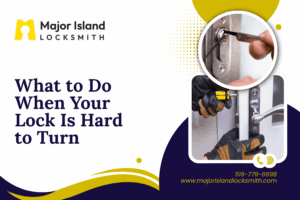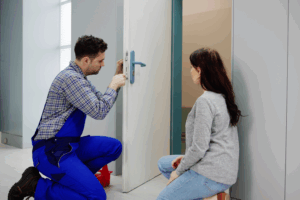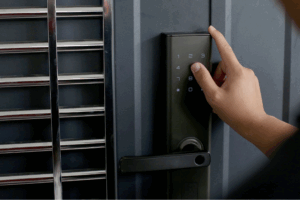Few things are as aggravating as encountering a door that stubbornly refuses to open, be it the entrance to your home, the car door, or an internal door within your property. Whether it’s due to a jammed lock, misalignment, or a broken handle, dealing with a door that won’t budge can be a significant inconvenience. In this comprehensive guide, we’ll delve into the common reasons why doors won’t open, provide detailed troubleshooting tips to help you resolve the issue, and discuss the potential costs associated with professional repairs.
Common Reasons Why Doors Won't Open:
1. Jammed Locks: A jammed lock is one of the most frequent culprits behind a door’s refusal to open. This can occur due to various reasons, such as a misaligned latch, a broken key stuck in the lock, or internal components that have seized up over time due to dirt, rust, or lack of lubrication.
2. Misaligned Door: A door that is not properly aligned within its frame can become difficult to open or close smoothly. Misalignment may occur due to factors such as changes in temperature and humidity, settling of the building’s foundation, or physical damage to the door or frame.
3. Broken Door Handle or Knob: A broken door handle or knob can render a door inaccessible. This may be caused by a faulty mechanism, loose connections between components, or physical damage to the handle itself, such as a cracked or stripped handle.
4. Warped Door: Wooden doors are particularly susceptible to warping, especially in environments with fluctuating humidity levels. Warping can cause a door to become stuck in its frame, making it difficult or impossible to open without intervention
Troubleshooting Tips:
Now that we’ve identified some common reasons why doors may refuse to open, let’s explore some troubleshooting tips to help you resolve the issue:
1. Check the Lock: Start by examining the lock mechanism to identify any visible obstructions or signs of damage. Attempt to lubricate the lock with graphite powder or a silicone-based lubricant to see if that resolves the issue. If there is a key stuck in the lock, use pliers or tweezers to carefully remove it.
2. Adjust the Door Alignment: If the door appears misaligned, try adjusting its position within the frame by tightening or loosening the hinges. Use a level to ensure the door is plumb and square before testing its operation. You may need to use shims or additional screws to properly align the door.
3. Examine the Door Handle: Inspect the door handle or knob for any signs of damage or wear. Tighten any loose screws or connections and test the handle to see if it operates smoothly. If necessary, replace the handle with a new one. Be sure to select a handle that is compatible with your door’s size and style.
4. Address Warping: If the door is visibly warped, attempt to gently straighten it using a combination of heat and pressure. Apply a damp cloth to the concave side of the door and use a heat gun to carefully apply heat, then place weights or clamps to hold the door flat as it cools. Keep in mind that this method may not be suitable for severe warping, and you may need to replace the door if it cannot be straightened.
Cost of Professional Repairs:
While many door issues can be resolved through DIY troubleshooting, there are instances where professional intervention may be necessary. Let’s explore the potential costs associated with professional repairs:
1. Locksmith Services: If you’re unable to resolve the issue with a jammed lock on your own, you may need to enlist the services of a professional locksmith. The cost of locksmith services can vary depending on factors such as the complexity of the lock, the time required for repairs, and the locksmith’s rates. On average, you can expect to pay anywhere from $100 to $300 for locksmith services.
2. Door Realignment: If your door is misaligned within its frame, you may need to hire a carpenter or door repair specialist to realign the door. The cost of door realignment can vary depending on the extent of the misalignment and the materials involved. On average, you can expect to pay between $100 and $500 for door realignment, depending on the complexity of the job.
3. Handle Replacement: If your door handle or knob is broken or damaged beyond repair, you’ll need to purchase a replacement handle and hire a professional to install it. The cost of handle replacement can vary depending on the type of handle, the complexity of the installation, and any additional materials required. On average, you can expect to pay between $50 and $200 for handle replacement, including both the cost of the handle and installation.
4. Door Replacement: In cases where a door is severely warped or damaged and cannot be repaired, you may need to replace the entire door. The cost of door replacement can vary depending on factors such as the size and material of the door, the complexity of the installation, and any additional features or hardware required. On average, you can expect to pay between $200 and $1000 or more for door replacement, including both the cost of the door and installation.
Comparing Door Types: Wood, Steel, and Fiberglass - Which Is Right for You?
Qualities of Different Types of Doors
| Quality | Wooden Doors | Steel Doors | Fiberglass Doors |
|---|---|---|---|
| Durability | Prone to warping, rotting, and termite damage | Resistant to warping, rust, and corrosion | Highly durable and resistant to weather damage |
| Insulation | Moderate insulation properties | Good insulation properties | Excellent insulation properties |
| Maintenance | Requires regular maintenance (painting, sealing) | Low maintenance, may require occasional painting | Low maintenance, resistant to dents and scratches |
| Security | Moderate security, can be reinforced with sturdy locks | High security, difficult to breach or break through | High security, reinforced with multiple layers |
| Appearance | Classic and timeless, natural wood grain | Modern and sleek, can mimic the look of wood | Versatile, can mimic various materials and styles |
| Cost | Moderate to high cost depending on wood quality and craftsmanship | Moderate cost, varies based on thickness and design | Moderate to high cost, depends on design and features |
Conclusion:
Dealing with a door that refuses to open can be a frustrating experience, but armed with the right knowledge and troubleshooting techniques, you can often resolve the issue yourself. However, if DIY efforts prove unsuccessful or if the problem is complex, don’t hesitate to seek the assistance of a professional locksmith or door repair specialist. By addressing the issue promptly and investing in necessary repairs, you can ensure that your doors continue to operate smoothly and securely, restoring peace and convenience to your daily life.
Ready to upgrade your doors? Explore our selection today and enhance the security, durability, and style of your home!




